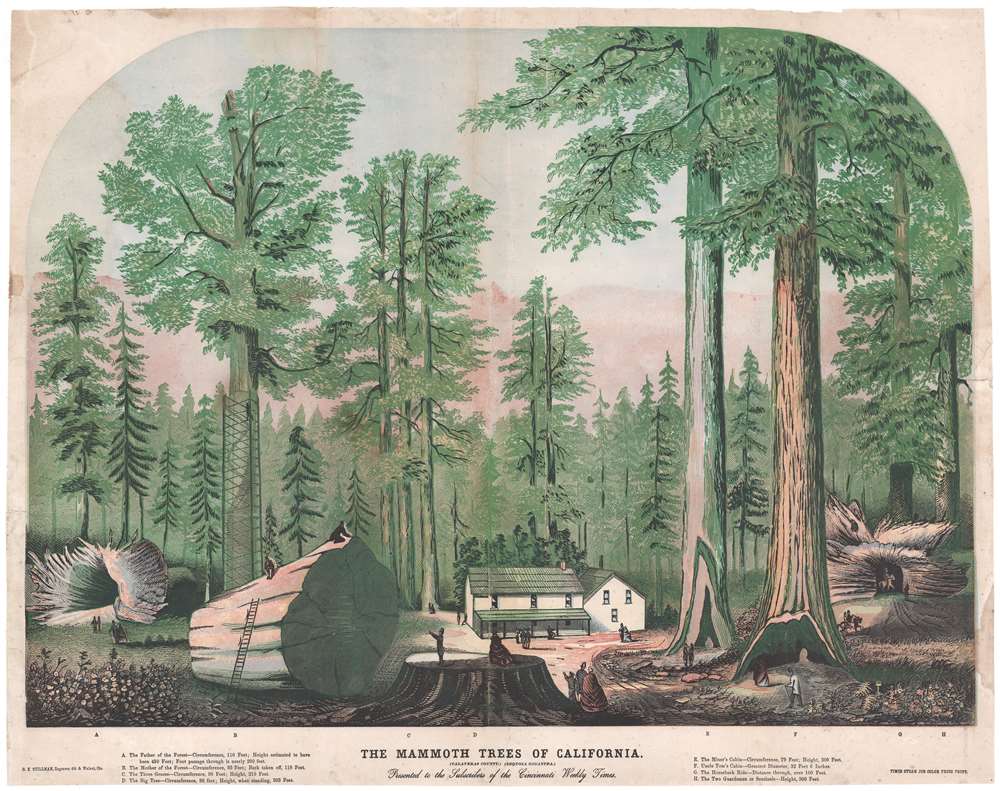1870 Stillman View of Giant Sequoia Trees, Calaveras County, California
MammothTrees-stillman-1870$1,500.00

Title
The Mammoth Trees of California. (Calaveras County.) (Sequoia Gigantea.)
1870 (undated) 20 x 25.75 in (50.8 x 65.405 cm)
1870 (undated) 20 x 25.75 in (50.8 x 65.405 cm)
Description
This is a c. 1870 George K. Stillman view of the giant sequoia trees at Calaveras Grove, Calaveras County, California. The grove depicted here is now part of Calaveras Big Trees State Park, the home to some of the oldest and largest surviving great sequoias.
Who Speaks for the Trees
Some of the most well-known trees from the grove, including the Father of the Forest, the Mother of the Forest, and the Three Graces, are illustrated and identified here. The Big Tree, known today as the Discovery Tree, appears here as a stump and a trunk in the foreground. The tree was felled in 1853 at the estimated age of 1,244 years. At the time it was the largest tree in the grove. Part of the trunk was toured to little fanfare and the stump was later turned into a dance floor. The conservationist John Muir penned an essay entitled 'The Vandals Then Danced Upon the Stump' to decry the felling. The Mother of the Forest, illustrated here behind the Discovery Tree and the second largest tree in the grove, suffered much the same indignity. It was stripped of its bark in sections 8 feet high by two to five feet wide. The bark sections were then shipped around Cape Horn to New York City, where they were reassembled for exhibition in the New York Crystal Palace. They were then shipped across the Atlantic to London, where they were on permanent display in London's Crystal Palace until it was destroyed by an 1866 fire.Preservation
Although the destruction of these two trees was heartbreaking, the subsequent exhibition of their remains caused a public outcry. As early as 1864, with the Yosemite Grant, initiatives were introduced to protect the giant sequoias. Even with the outcry, the protection for Yosemite did not extend further than the boundaries of the newly established park. The Calaveras groves, located to the northwest of Yosemite, remained in private hands despite repeated government purchase attempts. It was not until 1931 that the land was finally declared a state park (beginning with the North Grove). The park was expanded in 1954 with the purchase of the South Grove. Named Calaveras Big Trees State Park, it now encompasses 6,498 acres.Chromolithography
Chromolithography is a color lithographic technique developed in the mid-19th century. The process involved using multiple lithographic stones, one for each color, to yield a rich composite effect. Oftentimes, the process would start with a black basecoat upon which subsequent colors were layered. Some chromolithographs used 30 or more separate lithographic stones to achieve the desired product. Chromolithograph color could also be effectively blended for even more dramatic results. The process became extremely popular in the late 19th and early 20th centuries, when it emerged as the dominate method of color printing. The vivid color chromolithography produced made it exceptionally effective for advertising and propaganda imagery.Publication History and Census
This view was created by George K. Stillman and published c. 1870 by the Cincinnati Weekly Times. Three examples are cataloged in OCLC and are part of the institutional collections at the New York Botanical Garden, Yale University, and Stanford University. We also note examples in the collections at the University of California Berkeley and the Museum of Fine Arts Boston. Examples are scarce on the private market.Cartographer
George K. Stillman (1821 - January 25, 1891) was an American engraver. Born in Massachusetts, Stillman lived in Ohio from the late 1840s and resided in Cincinnati until his death. He served in the Union Army during the American Civil War in Company D of the 137th Regiment of the Ohio Infantry. He served from May 2, 1864 through August 19, 1864. He married Mary Nottingham on February 9, 1846, with whom he had three children. More by this mapmaker...
Condition
Very good. Mounted on linen.
References
OCLC 773170145. Bancroft Library, BANC PIC 1963.002:0379--D. Currey, L. and Kruska, D., Bibliography of Yosemite, the Central and the southern High Sierra, and the Big Trees, 1839-1900, 246. Larson III-165. Rumsey 4979.000.

